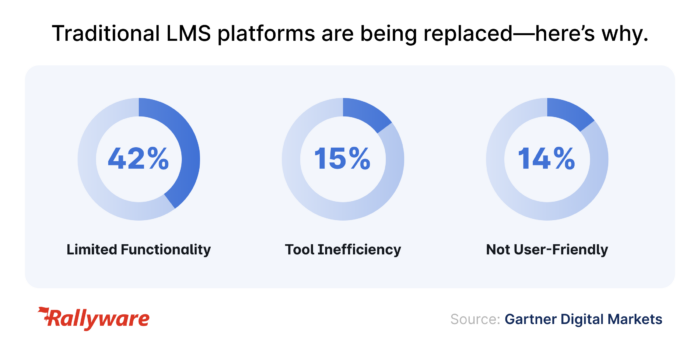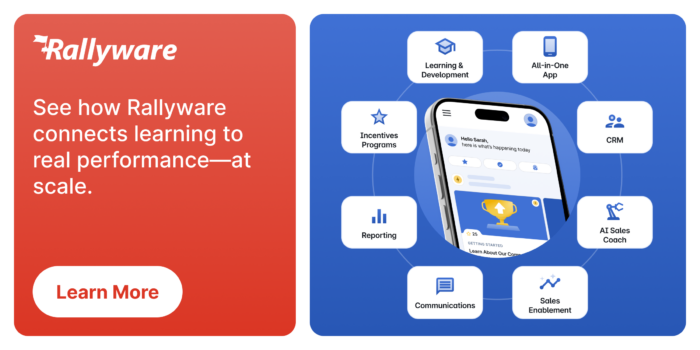Driving Digital Transformation of Enterprises through 2023
Frontline LMS: Why Traditional Learning Systems Fall Short in 2025
When your entire sales force is distributed, lightly managed, and performance-driven, every missed training moment is a missed revenue opportunity.
That’s the daily reality for enterprise leaders managing a workforce of field sellers, retail associates, non-payrolled reps and affiliates. You’re not dealing with office workers logging into compliance modules. You’re managing thousands of customer-facing sellers—most of whom never sit at a desk.
In that world, a traditional LMS isn’t just outdated—it’s a liability.
Because when your sellers are in the field, on the floor, or in front of the customer, training that’s static, generic, or buried in a desktop portal doesn’t just fall short—it disappears altogether.
The solution? A behavior-driven LMS built for the frontline.
But not the kind you’re picturing, not another course library or dashboard no one logs into.
We’re talking about a future-proof LMS system that thinks like your top performer, knows when a rep is struggling, nudges them with the right resource, and reinforces the behaviors that move the needle—on the floor, in the field, and across your entire sales force.
What Is a Frontline LMS?
A Frontline LMS (Learning Management System) is a platform purpose-built to train, engage, and activate employees who are on the move—often in non-traditional work environments.
Unlike legacy systems, a modern learning platform must be personalized, mobile-first, and designed to meet the needs of a distributed workforce. Unlike traditional LMS platforms designed for desk-based workers, a true frontline LMS is:
- Mobile-first
- Bite-sized and intuitive
- Integrated with performance data
- Personalized to the seller’s role and timing
- Built to scale across distributed workforces
It serves not just as a training tool, but as a real-time performance engine—nudging the right behaviors, reinforcing knowledge at the moment of need, and connecting learning to sales outcomes.
Corporate LMS Market Expansion
The corporate LMS sector is expected to reach $50.1 billion by 2030, growing at a CAGR of 23.8% from 2024 to 2030. This surge is driven by the rising demand for scalable and flexible training solutions, particularly in response to rapid technological changes and the need for employee upskilling. – GlobeNewswire
Industries that benefit most from a modern frontline LMS include:
- Brands with wholesale and DTC retail arms (e.g., Nike, Estée Lauder)
- Multi-brand retailers with distributed stores (e.g., Macy’s, REI)
- Affiliate-driven ecosystems (e.g., Gymshark, FanDuel)
- Field-based service and sales organizations (e.g., Vivint, LeafFilter)
- Independent agent-driven models (e.g., Primerica, Monat)
Frontline teams operate in a world that corporations often underestimate. It’s fast-moving, unpredictable, and deeply human. Every interaction is make-or-break—whether it’s a sales associate recommending the right product, a home services rep addressing objections on the doorstep, or a partner presenting your brand to a new account.
But the traditional LMS wasn’t built for this world. It was built for employees who work at a desk, have predictable schedules, and can afford to pause work for “learning time.” That’s not the frontline.
Here’s where the old model falls apart:
| Traditional LMS | Why It Fails | What Frontline Teams Actually Need |
| Desktop-first design | Training assumes access to a laptop or quiet space | Mobile-first access that fits the pace of the job |
| Static course libraries | Content is fixed, often outdated, and irrelevant to today’s priorities | Dynamic learning paths that evolve based on role, region, and performance |
| Generic training paths | Everyone gets the same modules, regardless of their responsibilities or goals | Personalized, just-in-time training tailored to the rep’s workflow |
| Completion-based metrics | Focus is on whether someone “finished” a course—not whether it made a difference | Insights tied to actual behaviors: productivity, engagement, and results |
These misalignments create a cascade of problems:
- Reps ignore the LMS because it doesn’t reflect their reality
- Managers lose visibility into who’s on track and who’s falling behind
- Enablement teams spend months building content no one uses
- Field performance stalls because training isn’t tied to action
And in the end, leadership is left asking a hard question: Why isn’t our training driving results?
The answer isn’t effort—it’s architecture. The traditional LMS was never designed to move at the speed of the frontline. It was designed to track completion, not spark behavior change.
If you want to train, support, and engage distributed reps at scale, you need a platform that meets them where they are—and evolves with what they need.
The Risk: Undertrained Frontline Teams = Missed Revenue
When frontline employees lack adequate training, the consequences extend beyond individual performance, they impact the organization’s bottom line. The truth is, frontline workers are drowning in information, and it’s costing companies.
According to research reported by the New York Post, 83% of frontline employees feel overwhelmed by the volume of information required to do their jobs, and 55% admit they’re more likely to make mistakes when under stress. Without structured, accessible training, even the most capable workers can falter leading to errors, missed revenue, and avoidable turnover.
Inadequate training isn’t just a performance issue, it’s a financial one. According to a study by KnowledgeCity, companies lose an average of $13.5 million per 1,000 employees every year due to insufficient training. Whether through errors, inefficiencies, or missed opportunities, the cost of underprepared teams adds up fast, especially on the frontline, where every interaction counts.
Traditional LMS software is falling short—and leaders are taking notice.
According to Gartner Digital Markets, 42% of businesses replaced their LMS between 2022 and 2023 due to limited functionality. An additional 15% cited tool inefficiency, and 14% pointed to poor user experience. In other words, the systems meant to support learning are often the very things holding teams back. For frontline organizations, these limitations aren’t minor—they’re blockers to productivity, engagement, and growth.

These findings underscore the importance of investing in effective training programs and LMS systems tailored to the unique needs of frontline employees. Without proper training:
- Ramp-up times for new hires increase, delaying their ability to contribute effectively.
- Opportunities for cross-selling and upselling are missed, as employees lack the knowledge to identify and act on them.
- Brand representation suffers, with inconsistencies in customer interactions leading to diminished brand loyalty.
- Employee turnover rises, resulting in additional recruitment and training costs.
In today’s competitive landscape, ensuring that frontline teams are well-trained is not just a matter of employee development—it’s a strategic imperative for business success.
The 2025 Checklist: What to Look for in a Frontline LMS
Not all LMS platforms are created equal—especially when your workforce doesn’t sit behind a desk. For organizations with distributed reps, channel sellers, retail associates, or field service teams, choosing the right LMS means looking well beyond feature lists.
You’re not just investing in a training tool. You’re choosing the system that will shape how your brand shows up in the field—every day.
Here’s what your next LMS needs to deliver if you’re serious about performance:
| Must-Have Capability | Why It Matters for the Frontline |
| Mobile-First UX | Frontline reps don’t have time to dig through clunky dashboards. They need intuitive, mobile-first access to learning that fits into a five-minute break or between customer appointments. If it’s not frictionless, it won’t be used. |
| Behavior-Based Recommendations | Most LMSs stop at “completed.” But what happens after? A modern platform uses real-time performance signals to recommend actions, content, or training based on what the rep actually needs—not what’s in the course catalog. |
| Role & Region Personalization | A one-size-fits-all learning path won’t work when you have hundreds—or thousands—of reps across markets, roles, and languages. Your LMS should localize content automatically and prioritize what’s relevant by location, role, or partner. |
| Integrated Analytics | What good is training if you can’t measure its impact? Your platform should track the downstream effect of learning: higher sales, better task compliance, faster onboarding, improved retention. If it’s not tied to KPIs, it’s not working. |
| Gamified Engagement | Motivation can’t be left to chance—especially for distributed teams. Gamification, progress tracking, and competitive elements keep reps coming back and engaging with content voluntarily, not just out of obligation. |
| Partner Content Enablement | If your business relies on retail partners, affiliates, or indirect sellers, your LMS must support easy, controlled distribution of branded content. That means the ability to manage visibility, versioning, and tracking—without manual work. |
These aren’t bells and whistles. They’re table stakes for driving real impact in modern frontline organizations. If you’re comparing solutions, make sure you understand the differences between today’s most talked-about platforms—LMS vs. LXP etc.
Most LMS platforms still focus on compliance, completion rates, and centralized control. That model might work for corporate training—but it’s a poor fit for sales – and service-driven environments where what matters most is execution.
If you’re evaluating vendors, bring this checklist into the room. It’ll help you cut through the noise.

Beyond LMS to Performance Enablement: What the Leaders Are Doing Differently
Forward-thinking organizations are shifting from training systems to performance ecosystems.
They’re not asking: Did the rep complete the course?
They’re asking: Did the training drive better outcomes?
That’s the difference between a traditional LMS and a platform like Rallyware—one that unifies learning, performance, and engagement in a single, scalable experience. A platform that doesn’t just deliver content, but drives measurable frontline impact.
Frontline Enablement Is a Strategic Investment
Whether you’re enabling 500 retail associates or 50,000 independent sellers, the right Frontline LMS isn’t just a tech purchase. It’s a growth lever.
In 2025, winning enterprises are those who can:
- Ramp reps faster
- Deliver knowledge at scale
- Personalize learning to performance
- Tie training to revenue
Ready to See What a Real Frontline LMS Looks Like?
Rallyware powers enablement for global brands, retailers, and distributed sales forces.
If you’re rethinking how to train and engage your frontline teams in 2025, we’ll show you what’s possible.
News and Insights on Workforce Training & Engagement
We’re among top-notch eLearning and business engagement platforms recognized for effective training and talent development, helping to empower distributed workforces
Subscribe
